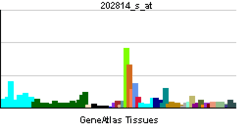HEXIM1
Protein HEXIM1 is a protein that in humans is encoded by the HEXIM1 gene.[1][2][3]
Interactions
HEXIM1 has been shown to interact with Cyclin T1.[2]
References
- ↑ Huang F, Wagner M, Siddiqui MA (Jul 2002). "Structure, expression, and functional characterization of the mouse CLP-1 gene". Gene 292 (1–2): 245–59. doi:10.1016/S0378-1119(02)00596-6. PMID 12119119.
- ↑ 2.0 2.1 Michels AA, Nguyen VT, Fraldi A, Labas V, Edwards M, Bonnet F et al. (Jun 2003). "MAQ1 and 7SK RNA Interact with CDK9/Cyclin T Complexes in a Transcription-Dependent Manner". Mol Cell Biol 23 (14): 4859–69. doi:10.1128/MCB.23.14.4859-4869.2003. PMC 162212. PMID 12832472.
- ↑ "Entrez Gene: HEXIM1 hexamethylene bis-acetamide inducible 1".
Further reading
- Dias Neto E, Correa RG, Verjovski-Almeida S, Briones MR, Nagai MA, da Silva W et al. (2000). "Shotgun sequencing of the human transcriptome with ORF expressed sequence tags". Proc. Natl. Acad. Sci. U.S.A. 97 (7): 3491–6. doi:10.1073/pnas.97.7.3491. PMC 16267. PMID 10737800.
- Ouchida R, Kusuhara M, Shimizu N, Hisada T, Makino Y, Morimoto C et al. (2003). "Suppression of NF-kappaB-dependent gene expression by a hexamethylene bisacetamide-inducible protein HEXIM1 in human vascular smooth muscle cells". Genes Cells 8 (2): 95–107. doi:10.1046/j.1365-2443.2003.00618.x. PMID 12581153.
- Wittmann BM, Wang N, Montano MM (2003). "Identification of a novel inhibitor of breast cell growth that is down-regulated by estrogens and decreased in breast tumors". Cancer Res. 63 (16): 5151–8. PMID 12941847.
- Yik JH, Chen R, Nishimura R, Jennings JL, Link AJ, Zhou Q (2003). "Inhibition of P-TEFb (CDK9/Cyclin T) kinase and RNA polymerase II transcription by the coordinated actions of HEXIM1 and 7SK snRNA". Mol. Cell 12 (4): 971–82. doi:10.1016/S1097-2765(03)00388-5. PMID 14580347.
- Paushkin SV, Patel M, Furia BS, Peltz SW, Trotta CR (2004). "Identification of a human endonuclease complex reveals a link between tRNA splicing and pre-mRNA 3' end formation". Cell 117 (3): 311–21. doi:10.1016/S0092-8674(04)00342-3. PMID 15109492.
- Yik JH, Chen R, Pezda AC, Samford CS, Zhou Q (2004). "A Human Immunodeficiency Virus Type 1 Tat-Like Arginine-Rich RNA-Binding Domain Is Essential for HEXIM1 To Inhibit RNA Polymerase II Transcription through 7SK snRNA-Mediated Inactivation of P-TEFb". Mol. Cell. Biol. 24 (12): 5094–105. doi:10.1128/MCB.24.12.5094-5105.2004. PMC 419863. PMID 15169877.
- Michels AA, Fraldi A, Li Q, Adamson TE, Bonnet F, Nguyen VT et al. (2005). "Binding of the 7SK snRNA turns the HEXIM1 protein into a P-TEFb (CDK9/cyclin T) inhibitor". EMBO J. 23 (13): 2608–19. doi:10.1038/sj.emboj.7600275. PMC 449783. PMID 15201869.
- Yik JH, Chen R, Pezda AC, Zhou Q (2005). "Compensatory contributions of HEXIM1 and HEXIM2 in maintaining the balance of active and inactive positive transcription elongation factor b complexes for control of transcription". J. Biol. Chem. 280 (16): 16368–76. doi:10.1074/jbc.M500912200. PMID 15713661.
- Byers SA, Price JP, Cooper JJ, Li Q, Price DH (2005). "HEXIM2, a HEXIM1-related protein, regulates positive transcription elongation factor b through association with 7SK". J. Biol. Chem. 280 (16): 16360–7. doi:10.1074/jbc.M500424200. PMID 15713662.
- Schulte A, Czudnochowski N, Barboric M, Schönichen A, Blazek D, Peterlin BM et al. (2005). "Identification of a cyclin T-binding domain in Hexim1 and biochemical analysis of its binding competition with HIV-1 Tat". J. Biol. Chem. 280 (26): 24968–77. doi:10.1074/jbc.M501431200. PMID 15855166. Vancouver style error (help)
- Wittmann BM, Fujinaga K, Deng H, Ogba N, Montano MM (2005). "The breast cell growth inhibitor, estrogen down regulated gene 1, modulates a novel functional interaction between estrogen receptor alpha and transcriptional elongation factor cyclin T1". Oncogene 24 (36): 5576–88. doi:10.1038/sj.onc.1208728. PMID 15940264.
- Shimizu N, Ouchida R, Yoshikawa N, Hisada T, Watanabe H, Okamoto K et al. (2005). "HEXIM1 forms a transcriptionally abortive complex with glucocorticoid receptor without involving 7SK RNA and positive transcription elongation factor b". Proc. Natl. Acad. Sci. U.S.A. 102 (24): 8555–60. doi:10.1073/pnas.0409863102. PMC 1150813. PMID 15941832.
- Li Q, Price JP, Byers SA, Cheng D, Peng J, Price DH (2005). "Analysis of the large inactive P-TEFb complex indicates that it contains one 7SK molecule, a dimer of HEXIM1 or HEXIM2, and two P-TEFb molecules containing Cdk9 phosphorylated at threonine 186". J. Biol. Chem. 280 (31): 28819–26. doi:10.1074/jbc.M502712200. PMID 15965233.
- Fraldi A, Varrone F, Napolitano G, Michels AA, Majello B, Bensaude O et al. (2006). "Inhibition of Tat activity by the HEXIM1 protein". Retrovirology 2: 42. doi:10.1186/1742-4690-2-42. PMC 1183248. PMID 15992410.
- Dulac C, Michels AA, Fraldi A, Bonnet F, Nguyen VT, Napolitano G et al. (2005). "Transcription-dependent association of multiple positive transcription elongation factor units to a HEXIM multimer". J. Biol. Chem. 280 (34): 30619–29. doi:10.1074/jbc.M502471200. PMID 15994294.
- Rual JF, Venkatesan K, Hao T, Hirozane-Kishikawa T, Dricot A, Li N et al. (2005). "Towards a proteome-scale map of the human protein-protein interaction network". Nature 437 (7062): 1173–8. doi:10.1038/nature04209. PMID 16189514.

